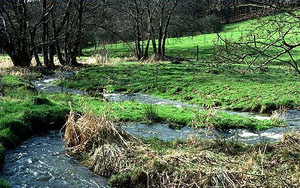
Creeks left to nature are a home to many unique species,
sometimes also to mussels. Picture: Klaus Bogon.
 Creeks left to nature are a home to many unique species, sometimes also to mussels. Picture: Klaus Bogon. |
Fresh water mussels are a specially good indicator for a water's condition. Due to their nutrition by filtering the water mussels on one hand have an important role for a water's ecology. On the other hand mussels are among the animals first spoiled by water pollution. By filtering water mussels get into contact with large amounts of water. So external factors strongly increase their effect.
Besides direct human influence on mussels and their environment, those are also factors spoiling water quality or mussels' other life conditions.
Pearl harvesting
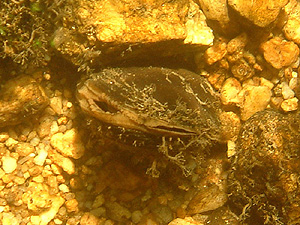 River pearl mussel (Margaritifera margaritifera). Picture: Christoph Riegler, herpetofauna.at. |
The European river pearl mussel (Margaritifera margaritifera) produces pearls the quality of which may compete with that of sea-living pearl mussels, such as oysters (Pinctada or Ostrea). The river pearl mussel living especially in the upper regions of creeks and small rivers rich in oxygen and low on calcium carbonate, has been used as pearl producer quite early in history.
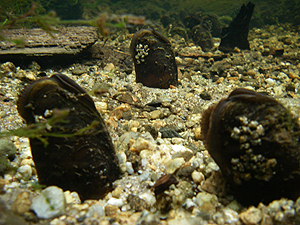 River pearl mussel beads, like this one in Sweden, are extre- mely rare in Europe. Picture: Joel Berglund. |
However, river pearl mussels need some 10 years to reach maturity and only every 2700th mussel really carries a pearl. That is why lords and ladies soon seized the right to harvest river pearls. Pearl fishers were employed to harvest the pearls without harming the mussels.
Pearl poachers, though, did not care for the damage done to the mussels. Though the penalties were draconian, pearl poaching could not be stopped and even today is something of a problem. The damages done were so severe that the river pearl mussel of Central Europe must be estimated extinguished in vast areas of its former occurrence.
Leisure areas at the waterside
The waterside usually has got a large value as a leisure and recreation area for man. Still waters, but also flowing waters such as rivers there is use in recreation and sports. That means for example boating and rafting as well as, of course swimming. The effect on the water fauna is as various as it is harmful. Besides mechanical destruction by crushing mussels, even protected species are collected for fun. Additionally there is harm by unlawful garbage disposal in lakes and rivers.
Change of rivers by constructions
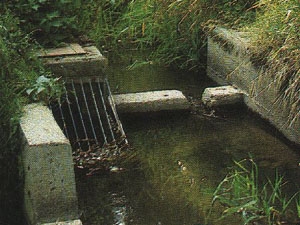 River changed by a channel construction. Source: LFU Bavaria. |
To be able to use rivers for transport, man often builds constructions to change the shape of natural waters, such as excavation riverbeds, straightening curving river parts and reinforcing river banks. All three measures noticeably harm the natural river life. Excavating riverbeds mechanically destroys the river floor and river bank fauna mussels are a part of which. Reinforcing river banks makes it impossible for many mussel species to dig themselves in and thus get a hold in the ground. The characteristic river bank biotopes are destroyed as well. Besides those direct effects there are more indirect ones, for example changes in the fish fauna. Most fresh water mussel species, however, need specific fish species for their larval development.
Sewage and industrial effluents
The introduction of sewages and industrial waste into rivers and lakes is one of the worst environmental sins of modern humanity. The list of effects is endless, not mentioning man himself using the same water. Mussels because of their filtration tend to accumulate poisons and other chemical agents from inside the water they breathe, in their body. That is why they are especially susceptible to the destructive effects of chemicals. One of those effects, for example, is the sterilization of whole mussel colonies by chemicals, such as certain acids in the water.
Eutrophication by excessive fertilising
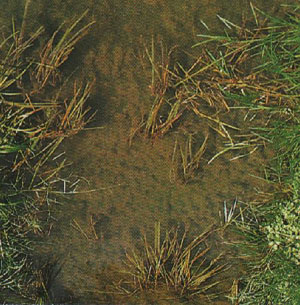 Silting up of a creek. Source: LFU Bavaria. |
Fertiliser mean higher yields and thus higher financial profit. This easy calculation has led to the absolute over-fertilisation of agricultural fields. Rain washes out the fertilisers into the ground water, as well as in the river's water. The nitrate inflow (fertilisers to a large extent consist of nitrates) means an excessive algae growth. After the algae's dying the amount of mud increases strongly as well. On the other hand the oxygen content of the river water decreases, followed by further dying of oxygen breathing animals. The increase in mud and silt of course has the largest consequences to mussels living on the river floor.
Acidification
Air pollution because of exhaustive gases from traffic, households and industry, especially nitrogen and sulphur oxides, together with the water content in the air lead to the formation of acids that are then washed out by the rain. The expression of acid rain today is generally known. Because of the acid rain the air pollution also influences the river water. Here the sinking pH value influences mussels as well as other water animals such as fish. Mussels, besides, suffer from a gradual destruction of their calcareous shell, especially susceptible to acid attacks, also their genital organs are harmed, causing infertility to a high extent.
Introduced predators
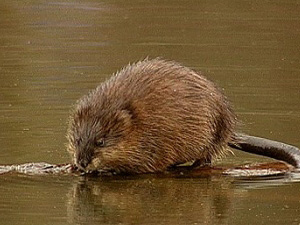 Muskrat (Ondathra zibethicus) (Picture: Leonard Lee Rue). |
|
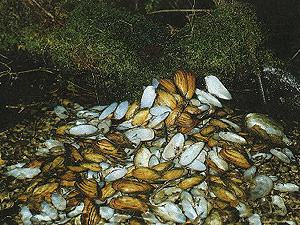 A muskrat's feeding place. Source: LFU Bavaria. |
Man by far is not the only being to feed on mussels. The muskrat introduced into European waters from America, sufficient vegetation prevailing, is a mere plant-eater. In winter, though, it feeds to a large extent on mussels living in the waters inhabited by the muskrat. Muskrats may pile up several thousand mussel shells each winter.
Changes in fauna composition
The European fauna has changed with unpredictable effects because of the introduction of foreign species. Some examples for the effect of introduced and immigrated species on European fresh water mussels are the already mentioned muskrat (Ondathra zibethicus), the rainbow trout (Oncorhynchus mykiss) and the zebra mussel (Dreissena polymorpha).
The muskrat has already been described. Besides that it feeds preferably on mussels in winter, it also digs deep holes into river banks and that way causes the destruction of river banks. Near the coast the digging in dykes by muskrats may have fatal effects. The muskrat has been introduced into Europe to serve as pelt producer, like it does in America.
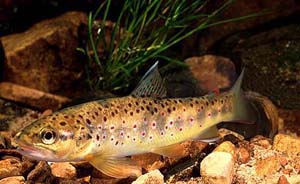 Brown trout (Salmo trutta fario). Picture: Klaus Bogon. |
The rainbow trout (Oncorhynchus mykiss) was introduced from America into European rivers to serve as food fish and to replace the smaller brown trout (Salmo trutta fario). The river pearl mussel, though, depends widely on the brown trout as a host fish to its glochidia. The rainbow trout, however, is immune against the river pearl mussel's glochidia. So replacement of native brown trout by introduced rainbow trout has come along with a strong decrease of mussels' reproduction.
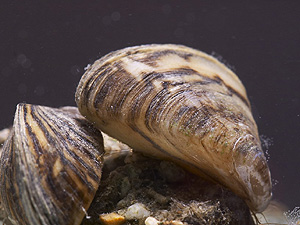 Zebra or wandering mussels (Dreissena polymorpha). Picture: By courtesy of Lars Peters. |
The zebra mussel (Dreissena polymorpha) basically comes from the Pontic and Caspian rivers of Asia. It has been distributed widely by transport ships on the rivers. Today it is to be found in all of Central and Eastern Europe. The zebra mussel reproduces by planktontic larvae, as do the sea-living mussels. Those larvae during their planktontic phase lasting about eight days are further distributed by the river currents. In some places the zebra mussels have grown so many, that every place on the river floor, as well as all animals with hard exterior, such as mussels and crayfish, are completely overgrown. Large damage is done to water based industry, as the pumping stations as well as wells and tubes are blocked by the mass of zebra mussels inside.